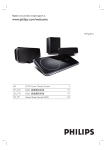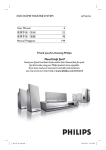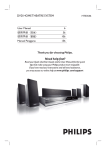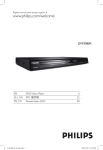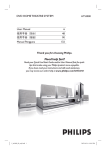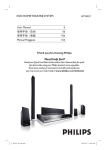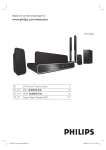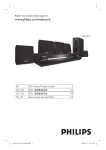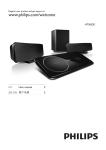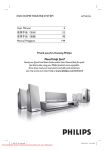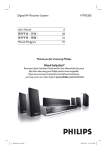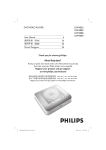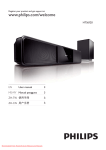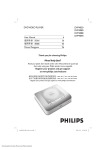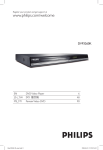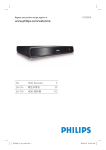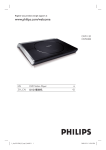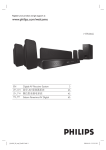Download Philips HTS3156 DVD home theater system
Transcript
Register your product and get support at
www.philips.com/welcome
HTS3156
EN
ZH_CN
ZH_TW
MS_MY
DVD Home Theater System
DVD 家庭影院系统
DVD 家庭劇院系統
Sistem Teater Rumah DVD
1_hts3156_98_eng2_final820.indd 1
6
52
98
144
2008-05-09 5:18:50 PM
᳝↦᳝ᆇ⠽䋼ܗ㋴
+D]DUGRXV7R[LF6XEVWDQFH
䚼ӊৡ⿄
䪙
1DPHRIWKH3DUWV 3E/HDG
䬝&G
∲+J
0HUFXU\ &DGPLXP
݁Ӌ䫀
⒈㘨㣃
&KURPLXP 3%%
⒈Ѡ㣃䝮
3%'(˅
+RXVLQJ
O
O
O
O
O
O
'9'ORDGHU
'9'Ⲧܝ
6XEZRRIHU
䍙䞡Ԣ䷇ㆅ
X
O
O
O
O
O
X
O
O
O
O
O
/RXGVSHDNHUV
ুऩܗ
O
O
O
O
O
O
3:%V
⬉䏃ᵓ㒘ӊ
X
O
O
O
O
O
$FFHVVRULHV
5HPRWHFRQWURO
FDEOHV
䰘ӊ˄䘹఼ˈ
⬉⑤㒓ˈ䖲㒓˅
X
O
O
O
O
O
%DWWHULHVLQ
5HPRWH&RQWURO
=Q&
䘹఼⬉∴
X
O
O
O
O
O
ƻ˖㸼⼎䆹᳝↦᳝ᆇ⠽䋼䆹䚼ӊ᠔᳝ഛ䋼ᴤ᭭Ёⱘ䞣ഛ6-7ᷛޚ㾘ᅮⱘ䰤䞣㽕∖ҹϟDŽ
O: Indicates that this toxic or hazardous substance contained in all of the homogeneous
materials for this part is below the limit requirement in SJ/T11363 – 2006.
h˖㸼⼎䆹᳝↦᳝ᆇ⠽䋼㟇ᇥ䆹䚼ӊⱘᶤϔഛ䋼ᴤ᭭Ёⱘ䞣䍙ߎ6-7̢ᷛޚ㾘ᅮⱘ䰤䞣㽕∖DŽ
X: Indicates that this toxic or hazardous substance contained in at least one of the
homogeneous materials used for this part is above the limit requirement in SJ/T11363 - 2006.
⦃ֱՓ⫼ᳳ䰤Environmental Protection Use Period
ℸᷛ䆚ᣛᳳ䰤˄कᑈ˅ˈ⬉ᄤֵᙃѻકЁ᳝ⱘ᳝↦᳝ᆇ⠽䋼ܗ㋴ℷᐌՓ⫼ⱘᴵӊϟϡӮথ
⫳⊘さবˈ⫼᠋Փ⫼䆹⬉ᄤֵᙃѻકϡӮᇍ⦃๗䗴៤Ϲ䞡∵ᶧᇍ݊Ҏ䑿ǃ䋶ѻ䗴៤Ϲ䞡ᤳᆇ
ⱘᳳ䰤DŽ
This logo refers to the period ( 10 years ) during which the toxic or hazardous substances or elements
contained in electronic information products will not leak or mutate so that the use of these [substances or
elements] will not result in any severe environmental pollution, any bodily injury or damage to any assets.
⬉∴ᷛ䆚Battery labeling logo
⦃ֱՓ⫼ᳳ䰤Environmental Protection Use Period
ℸᷛ䆚ᣛᳳ䰤˄Ѩᑈ˅ˈ⬉∴Ё᳝ⱘ᳝↦᳝ᆇ⠽䋼ܗ㋴ℷᐌՓ⫼ⱘᴵӊϟϡӮথ⫳⊘さ
বˈ⫼᠋Փ⫼䆹⬉∴ѻકϡӮᇍ⦃๗䗴៤Ϲ䞡∵ᶧᇍ݊Ҏ䑿ǃ䋶ѻ䗴៤Ϲ䞡ᤳᆇⱘᳳ䰤DŽ
This logo refers to the period ( 5 years ) during which the toxic or hazardous substances or elements
contained in the battery will not leak or mutate so that the use of these [substances or elements] will not
result in any severe environmental pollution, any bodily injury or damage to any assets.
2
1_hts3156_98_eng2_final820.indd 2
2008-05-09 5:18:53 PM
LASER
Type
Wave length
Output Power
Beam divergence
Semiconductor laser
GaAIAs
650 - 660 nm (DVD)
784 - 796 nm (CD)
7 mW (DVD)
10 mW (VCD/CD)
60 degrees
Manufactured under license from Dolby
Laboratories. Dolby, Pro Logic and the
double-D symbol are trademarks of Dolby
Laboratories.
Manufactured under license under U.S.
Patent #’s: 5,451,942; 5,956,674; 5,974,380;
5,978,762; 6,487,535 & other U.S. and
worldwide patents issued & pending. DTS
and DTS Digital Surround are registered
trademarks and the DTS logos and Symbol
are trademarks of DTS, Inc. © 1996-2007
DTS, Inc. All Rights Reserved.
‘CONSUMERS SHOULD NOTE THAT NOT ALL HIGH
DEFINITION TELEVISION SETS ARE FULLY
COMPATIBLE WITH THIS PRODUCT AND MAY CAUSE
ARTIFACTS TO BE DISPLAYED IN THE PICTURE. IN
CASE OF 525 OR 625 PROGRESSIVE SCAN PICTURE
PROBLEMS, IT IS RECOMMENDED THAT THE USER
SWITCH THE CONNECTION TO THE ‘STANDARD
DEFINITION’ OUTPUT. IF THERE ARE QUESTIONS
REGARDING OUR TV SET COMPATIBILITY WITH THIS
MODEL 525p AND 625p DVD PLAYER, PLEASE
CONTACT OUR CUSTOMER SERVICE CENTER.’
DivX, DivX Ultra Certified, and associated
logos are trademarks of DivX, Inc. and are
used under license.
Official DivX® Ultra Certified product.
Plays all versions of DivX® video (including
DivX® 6) with enhanced playback of DivX®
media files and the DivX® Media Format.
CAUTION
Use of controls or adjustments or performance
of procedures other than herein may result in
hazardous radiation exposure or other unsafe
operation.
Windows Media and the Windows logo are
trademarks, or registered trademarks of
Microsoft Corporation in the United States
and/or other countries.
ATTENTION!
For Customer Use:
Read carefully the information located at the
bottom or rear of your DVD Home Theatre
System and enter below the Serial No. Retain
this information for future reference.
Model No.
HTS3156
Serial No.
_______________
3
1_hts3156_98_eng2_final820.indd 3
2008-05-09 5:18:54 PM
Language Code
Abkhazian
6566
Afar
6565
Afrikaans
6570
Amharic
6577
Arabic
6582
Armenian
7289
Assamese
6583
Avestan
6569
Aymara
6589
Azerhaijani
6590
Bahasa Melayu
7783
Bashkir
6665
Belarusian
6669
Bengali
6678
Bihari
6672
Bislama
6673
Bokmål, Norwegian
7866
Bosanski
6683
Brezhoneg
6682
Bulgarian
6671
Burmese
7789
Castellano, Español
6983
Catalán
6765
Chamorro
6772
Chechen
6769
Chewa; Chichewa; Nyanja 7889
9072
中文
Chuang; Zhuang
9065
Church Slavic; Slavonic 6785
Chuvash
6786
Corsican
6779
Česky
6783
Dansk
6865
Deutsch
6869
Dzongkha
6890
English
6978
Esperanto
6979
Estonian
6984
Euskara
6985
6976
Faroese
7079
Français
7082
Frysk
7089
Fijian
7074
Gaelic; Scottish Gaelic 7168
Gallegan
7176
Georgian
7565
Gikuyu; Kikuyu
7573
Guarani
7178
Gujarati
7185
Hausa
7265
Herero
7290
Hindi
7273
Hiri Motu
7279
Hrwatski
6779
Ido
7379
Interlingua (International)7365
Interlingue
7365
Inuktitut
7385
Inupiaq
Irish
Íslenska
Italiano
Ivrit
Japanese
Javanese
Kalaallisut
Kannada
Kashmiri
Kazakh
Kernewek
Khmer
Kinyarwanda
Kirghiz
Komi
Korean
Kuanyama; Kwanyama
Kurdish
Lao
Latina
Latvian
Letzeburgesch;
Limburgan; Limburger
Lingala
Lithuanian
Luxembourgish;
Macedonian
Malagasy
Magyar
Malayalam
Maltese
Manx
Maori
Marathi
Marshallese
Moldavian
Mongolian
Nauru
Navaho; Navajo
Ndebele, North
Ndebele, South
Ndonga
Nederlands
Nepali
Norsk
Northern Sami
North Ndebele
Norwegian Nynorsk;
Occitan; Provencal
Old Bulgarian; Old Slavonic
Oriya
Oromo
Ossetian; Ossetic
Pali
Panjabi
Persian
Polski
Português
7375
7165
7383
7384
7269
7465
7486
7576
7578
7583
7575
7587
7577
8287
7589
7586
7579
7574
7585
7679
7665
7686
7666
7673
7678
7684
7666
7775
7771
7285
7776
7784
7186
7773
7782
7772
7779
7778
7865
7886
7868
7882
7871
7876
7869
7879
8369
7868
7878
7967
6785
7982
7977
7983
8073
8065
7065
8076
8084
Pushto
Russian
Quechua
Raeto-Romance
Romanian
Rundi
Samoan
Sango
Sanskrit
Sardinian
Serbian
Shona
Shqip
Sindhi
Sinhalese
Slovensky
Slovenian
Somali
Sotho; Southern
South Ndebele
Sundanese
Suomi
Swahili
Swati
Svenska
Tagalog
Tahitian
Tajik
Tamil
Tatar
Telugu
Thai
Tibetan
Tigrinya
Tonga (Tonga Islands)
Tsonga
Tswana
Türkçe
Turkmen
Twi
Uighur
Ukrainian
Urdu
Uzbek
Vietnamese
Volapuk
Walloon
Welsh
Wolof
Xhosa
Yiddish
Yoruba
Zulu
8083
8285
8185
8277
8279
8278
8377
8371
8365
8367
8382
8378
8381
8368
8373
8373
8376
8379
8384
7882
8385
7073
8387
8383
8386
8476
8489
8471
8465
8484
8469
8472
6679
8473
8479
8483
8478
8482
8475
8487
8571
8575
8582
8590
8673
8679
8765
6789
8779
8872
8973
8979
9085
4
1_hts3156_98_eng2_final820.indd 4
2008-05-09 5:18:55 PM
English ------------------------------------ 6
English
Index
----------------------------- 52
Bahasa Melayu ----------------------- 144
Where the MAINS plug or an appliance
coupler is used as the disconnect device, the
disconnect device shall remain readily
operable.
Bahasa Melayu
----------------------------- 98
Ensure that the power outlet is always within
reach. If abnormal situations occur, fully
disconnect power: unplug the power cord
from the power outlet.
This product incorporates copyright protection
technology that is protected by method claims of
certain U.S. patents and other intellectual property
rights owned by Macrovision Corporation and
other rights owners. Use of this copyright
protection technology must be authorised by
Macrovision Corporation, and is intended for
home and other limited viewing uses only unless
otherwise authorised by Macrovision Corporation.
Reserve engineering or disassembly is prohibited.
通过此网站注册您的产品并获得支持:
www.philips.com/welcome
5
1_hts3156_98_eng2_final820.indd 5
2008-05-09 5:18:55 PM
Table of contents
English
General
General Information ........................................................................................................ 8
Setup precautions.................................................................................................................................................8
Accessories supplied ...........................................................................................................................................8
Cleaning discs ........................................................................................................................................................8
About recycling .....................................................................................................................................................8
Product Overview
Main Unit ........................................................................................................................... 9
Remote Control .........................................................................................................10-12
Using the remote control ................................................................................................................................12
Connections
Basic Connections .....................................................................................................13-16
Step 1: Placing the speakers.............................................................................................................................13
Step 2: Connecting to TV ................................................................................................................................14
Option 1: Connecting to the Video socket .........................................................................................14
Option 2: Connecting to a Progressive Scan TV or component video input ............................14
Step 3: Connecting speakers and subwoofer .............................................................................................15
Step 4: Connecting the FM and AM/MW antennas ..................................................................................16
Step 5: Connecting the power cord ..............................................................................................................16
Optional Connections .................................................................................................... 17
Connecting audio from other devices ..........................................................................................................17
Basic Setup
Getting Started ..........................................................................................................18-22
Finding the correct viewing channel .............................................................................................................18
Switching to different play source .................................................................................................................18
Setting language preferences...........................................................................................................................19
On-screen display (OSD) language ........................................................................................................19
Audio, Subtitle and Menu language for DVD playback ...............................................................19-20
Setting up Progressive Scan feature ..............................................................................................................21
Setting the speakers’ channels ....................................................................................................................... 22
Disc Playback
Disc Operations .........................................................................................................23-31
Playable discs .......................................................................................................................................................23
Playing a disc ........................................................................................................................................................23
Basic playback controls.....................................................................................................................................24
Selecting various repeat/shuffle functions...................................................................................................24
Programming disc tracks ................................................................................................................................. 25
Other playback features for video discs (DVD/VCD/SVCD) ......................................................... 25-28
Using the Disc Menu ................................................................................................................................. 25
Viewing playback information ..................................................................................................................26
Zooming.........................................................................................................................................................26
Changing subtitle language .......................................................................................................................26
Switching camera angles ............................................................................................................................26
Changing sound track language ...............................................................................................................27
Setting the delay times for audio playback...........................................................................................27
Playback Control (VCD only)..................................................................................................................27
Preview function (VCD/SVCD only) .................................................................................................... 28
6
1_hts3156_98_eng2_final820.indd 6
2008-05-09 5:18:56 PM
Playing a MP3/ WMA disc ................................................................................................................................29
Playing a JPEG image file (slide show) .......................................................................................................... 30
Preview function ......................................................................................................................................... 30
Zooming........................................................................................................................................................ 30
Flip/Rotate picture ..................................................................................................................................... 30
Playing music and photo files simultaneously .............................................................................................31
Playing a DivX disc .............................................................................................................................................31
English
Table of contents
Playback other supported devices
Playback - Karaoke ......................................................................................................... 32
Playing a Karaoke disc .......................................................................................................................................32
Microphone setting.....................................................................................................................................32
Playback - USB Device ................................................................................................... 33
Playing from a USB device................................................................................................................................33
Playback - Other Audio Player ..................................................................................... 34
Playing from other portable audio player ................................................................................................... 34
Setup Options
Setup Menu Options................................................................................................. 35-40
Accessing the setup menu.........................................................................................................................35-40
General Setup Page ....................................................................................................................................36
Audio Setup Page ........................................................................................................................................37
Video Setup Page........................................................................................................................................ 38
Preference Page ....................................................................................................................................39-40
Radio Tuning
Radio Operations .......................................................................................................41-42
Tuning to radio stations....................................................................................................................................41
Changing tuning grid ..........................................................................................................................................41
Presetting radio stations ........................................................................................................................... 41-42
Using auto install .........................................................................................................................................41
Using automatic preset..............................................................................................................................42
Using manual preset ...................................................................................................................................42
Selecting a preset radio station ......................................................................................................................42
Deleting a preset radio station.......................................................................................................................42
Others
Sound and Volume Controls ......................................................................................... 43
Volume control ...................................................................................................................................................43
Selecting surround sound.................................................................................................................................43
Selecting digital sound effects .........................................................................................................................43
Other Features................................................................................................................ 44
Installing the latest software .......................................................................................................................... 44
Troubleshooting ........................................................................................................ 45-47
Glossary...................................................................................................................... 48-49
Specifications .................................................................................................................. 50
7
1_hts3156_98_eng2_final820.indd 7
2008-05-09 5:18:56 PM
General Information
English
WARNING!
This unit does not contain any userserviceable parts. Please leave all
maintenance work to qualified
personnel.
Setup precautions
Finding a suitable location
– Place this unit on a flat, hard and
stable surface. Never place the unit on a
carpet.
– Never place this unit on top of other
equipment that might heat it up (e.g.,
receiver or amplifier).
– Never put anything under this unit
(e.g., CDs, magazines).
– Install this unit near the AC outlet
where the AC power plug can be easily
reached.
Space for ventilation
– Place this unit in a location with
adequate ventilation to prevent internal
heat build up. Allow at least 10 cm (4”)
clearance from the rear and the top of
this unit and 5cm (2”) from the left and
right to prevent overheating.
Avoid high temperature, moisture,
water and dust
– This unit must not be exposed to
dripping or splashing.
– Never place any object or items that
can damage this unit (e.g., liquid filled
objects, lighted candles).
Accessories supplied
–
–
–
–
–
–
–
–
–
–
1 subwoofer
2 front speakers
2 rear speakers
1 centre speaker
1 remote control with batteries
1 composite video cable (yellow)
1 FM wire antenna
1 AM/MW loop antenna
1 power cable
Quick Start Guide
Cleaning discs
To clean a disc, use a micro fibre cleaning
cloth and wipe the disc from the centre
to the edge in a straight line.
CAUTION!
Never use solvents e.g. benzene, thinner,
commercially available cleaners, or antistatic sprays intended for discs.
About recycling
These operating instructions have been
printed on non-polluting paper. The
electronic equipment contains a large
number of materials that can be recycled.
If you are disposing of an old machine,
please take it to a recycling centre.
Please observe the local regulations
regarding disposal of packaging materials,
exhausted batteries and old equipment.
8
1_hts3156_98_eng2_final820.indd 8
2008-05-09 5:18:56 PM
Front Panel View
1
2
3
English
Main Unit
Side Panel
4
5
6
7
8
9
10
11 12
a STANDBY-ON
h STOP
– Turns on this unit or turns off to normal
standby mode.
b Disc Tray
– Exits an operation.
– DISC: stops playback.
– RADIO: press and hold this button to
erase the current preset radio station.
c OPEN/CLOSE ç
– Opens/closes the disc tray.
i VOL
– Adjusts the volume level.
d Display panel
j USB socket
– Input for USB flash drive or USB memory
card reader.
e PLAY/ PAUSE u
– DISC: starts/pauses playback.
– RADIO: starts auto radio installation for
first time setup.
f SOURCE
k MP3 LINE-IN socket
– Phono input for connecting to the
headphone out socket on your portable
audio player.
– Selects the relevant active source mode:
DISC, FM, AM/MW, TV, AUX,
MP3 LINE-IN.
l MIC socket
– For microphone connection.
g MIC LEVEL
– Activates microphone level mode and
use the volume control to set the
microphone volume level.
9
1_hts3156_98_eng2_final820.indd 9
2008-05-09 5:18:56 PM
Remote Control
English
c OPEN/CLOSE ç
1
– Opens/closes the disc tray.
2
d PROGRAM
– DISC: starts programming.
– RADIO: press and hold this button to
start automatic/ manual preset
programming.
3
ZOOM
4
65
6
e ZOOM
– Zoom in or out the picture on the TV.
7
8
9
10
11
VOCAL
KARAOKE
12
13
f SETUP
– Enters or exits the system setup menu.
g DISPLAY
– Displays the current status or disc
information.
– Selects a different viewing angle of a DVD
movie (if available).
h PLAY/PAUSE u
– DISC: starts/pauses playback.
– RADIO: starts auto radio installation for
first time setup.
i STOP x
– Exits an operation.
– DISC: stops playback.
– RADIO: press and hold this button to
erase the current preset radio station.
a 2
– Turns on this unit or turns off to normal
standby mode.
j TV VOL +/-
b Source buttons
k AUDIO SYNC
– DISC/USB: switches to DISC or USB
mode.
RADIO: switches to FM or AM/MW
band.
TV: switches to TV mode. The sound
from the TV will output through the
connected speaker system.
AUX/DI: switches to AUX external
source mode.
MP3 LINE-IN: switches to MP3 LINEIN external source mode.
– Adjusts the volume of the TV (for Philips
TVs or compatible brands only).
– Sets the audio output delay times if the
video playback is slower than the audio
output.
l KARAOKE
– Enters microphone setting menu.
m VOCAL
– Toggles between various audio mode.
10
1_hts3156_98_eng2_final820.indd 10
2008-05-09 5:18:57 PM
Remote Control (continued)
English
n DISC MENU
– For DVD, enters or exits disc contents
menu.
– For VCD/SVCD, enters digest menu.
o OK
– Confirms an entry or selection.
p vVb B
– DISC: selects movement direction in the
menu.
– DISC: press left or right for fast forward
and backward search.
– RADIO: press up or down to tune the
radio frequency.
– RADIO: press left or right to start auto
search.
q TITLE
– For DVD, go back to the previous menu.
– For VCD version 2.0 only;
During playback, display the disc title
menu or return to the main menu.
r PREVí / NEXT ë
ZOOM
14
15
16
17
18
19
20
21
22
23
24
VOCAL
KARAOKE
25
– DISC: skips to the previous or next title/
chapter/track.
– RADIO: selects a preset radio station.
s MUTE %
– Mutes or restores the volume.
t VOL +/– Adjusts the volume level.
u SURROUND
– Selects multi-channel surround or
stereo mode.
x SUBTITLE
– Selects a DVD subtitle language.
y AUDIO
– DISC: selects an audio language/channel.
v Numeric keypad 0-9
– Enters a track/title number of the disc.
– Enters a number of a preset radio station.
w SOUND
– Selects a predefined sound effect.
11
1_hts3156_98_eng2_final820.indd 11
2008-05-09 5:18:57 PM
Remote Control (continued)
English
Using the remote control
CAUTION!
– Remove batteries if they are
exhausted or if the remote control
is not to be used for a long time.
– Never mix batteries (old and new
or carbon and alkaline, etc).
– Batteries contain chemical
substances, they should be disposed
of properly.
A Open the battery compartment.
B Insert two batteries type R03 or AAA,
following the indications (+-) inside
the compartment.
C Close the cover.
D Point the remote control directly at the
remote sensor (iR) on the front panel.
E Select the source you wish to control by
pressing the DISC/USB, RADIO, TV,
AUX/DI or MP3 LINE-IN button on the
remote control.
F Then select the desired function (for
example í, ë).
12
1_hts3156_98_eng2_final820.indd 12
2008-05-09 5:18:57 PM
REAR
LEFT
English
Basic Connections
FRON
T
LEFT
CENT
ER
REAR
RIGHT
Step 1: Placing the speakers
The Philips Home Theatre System is
simple to install. However, proper system
placement is critical to ensure an
optimum sound experience.
A Place the front left and right speakers at
equal distances from the TV and at an
angle of approximately 45 degrees from
the listening position.
B Place the centre speaker above the TV or
the main unit such that the centre
channel’s sound is localised.
FRON
T
RIGHT
SUB
WO
OFE
R
Helpful Hints:
– The placement diagram shown here is
only a guideline that provides great system
performance. You may find other placement
choices that are more suitable for your room
layout that provide the sound experience you
enjoy.
– To avoid magnetic interference, never
position the front speakers too close to your
TV.
– The rear speakers are labelled as REAR
LEFT or REAR RIGHT.
– The front speakers are labelled as
FRONT LEFT or FRONT RIGHT.
– For speaker setting, see ‘Getting Started Setting the speakers’ channel’.
C Place the rear speakers at normal
listening ear level facing each other or
hang on the wall.
D Place the subwoofer at the corner of the
room. Otherwise, keep it at least one
metre away from the TV.
13
1_hts3156_98_eng2_final820.indd 13
2008-05-09 5:18:57 PM
Basic Connections (continued)
English
Option 1
Option 2
Main Unit (rear)
SPEAKERS
Step 2: Connecting to TV
This connection enables you to view the
video playback from this unit. You only
need to choose one of the options
below to make the video connection.
– For a standard TV, follow option 1.
– For a progressive scan TV, follow
option 2.
Helpful Hints:
– It is important to connect this unit directly
to the TV in order to enjoy optimum video
quality.
– To hear the TV audio through this unit,
connect the AUDIO IN sockets on the unit to
the audio output sockets on your TV (audio
cables not supplied). Press TV on the remote
control when watching the TV programs.
AM/
MW
Option 2: Connecting to a
Progressive Scan TV or component
video input
The progressive scan video quality is only
available when using Y Pb Pr connection
and a progressive scan TV is required. It
provides superior picture quality when
watching DVD movies.
A Use the component video cables (red/
blue/green - not supplied) to connect the
Y Pb Pr sockets on the main unit to the
corresponding component video input
sockets (or labeled as Y Pb/Cb Pr/Cr or
YUV) on the TV.
It provides better picture quality.
B If your TV accepts progressive signals,
proceed to chapter ‘Getting Started Setting up Progressive Scan feature’ for
detailed progressive feature setup.
Option 1: Connecting to the Video
socket
Use a composite video cable (yellow supplied) to connect the CVBS socket
on the main unit to the video input
socket (or labeled as A/V In, Video In,
Composite or Baseband) on the TV.
It provides good picture quality..
14
1_hts3156_98_eng2_final820.indd 14
2008-05-09 5:18:57 PM
FRONT
RIGHT
FRONT
LEFT
FRONT CENTRE
REAR
RIGHT
English
Basic Connections (continued)
REAR
LEFT
SUBWOOFER
Main Unit (rear)
SPEAKERS
Step 3: Connecting speakers
and subwoofer
Connect all the speakers and subwoofer
to the matching sockets at the rear of the
main unit, Make sure that the colours of
the plugs and sockets are matched.
Helpful Hint:
– To prevent unwanted noise, never place
the speakers too close to the main unit,
subwoofer, AC power adapter, TV or any
other radiation sources.
15
1_hts3156_98_eng2_final820.indd 15
2008-05-09 5:18:57 PM
Basic Connections (continued)
English
fix the claw
into the slot
Main Unit (rear)
SPEAKERS
AM/
MW
FM
antenna
1
AM/MW
antenna
2
AM/
MW
Step 4: Connecting the
FM and AM/MW
antennas
A Connect the supplied AM/MW loop
antenna to the AM/MW socket. Place
the AM/MW loop antenna on a shelf, or
attach it to a stand or wall.
B Connect the supplied FM antenna to the
FM 75 Ω socket. Extend the FM antenna
and fix its ends to the wall.
Step 5: Connecting the
power cord
Notes:
– For power supply rating, refer to the
rear or bottom of the main unit.
– Turning off to standby mode does not
disconnect the unit from mains.
A When all the connections are complete,
set the voltage selector to the local
power line voltage.
For better FM stereo reception, connect
an external FM antenna (not supplied).
B Connect the AC power cord to the
Helpful Hints:
– Adjust the position of the antennas for
optimal reception.
– Position the antennas as far away as
possible from your TV, VCR or other
radiation source to prevent any unwanted
interference.
power outlet.
The standby LED on the main unit
lights up.
Helpful Hint:
– Before making or changing any
connections, make sure that all the devices
are disconnected from the power outlet.
16
1_hts3156_98_eng2_final820.indd 16
2008-05-09 5:18:58 PM
English
Optional Connections
OR
DVD Recorder/
VCR/ Cable/
Satellite Box
Main Unit (rear)
SPEAKERS
Connecting audio from other
devices
This unit provides analog audio
connection. You can connect the audio
output from an audio/video device (e.g.
DVD Recorder, VCR, Cable/Satellite
Box, game console or TV) to the main
unit in order to enjoy the multi-channel
surround sound capabilities.
AM/
MW
Use an audio cable (not supplied) to
connect the AUDIO IN-TV sockets on
the main unit to the AUDIO OUT
sockets on the connected device.
OR
Use an audio cable (not supplied) to
connect the AUDIO IN-AUX sockets
on the main unit to the AUDIO OUT
sockets on the connected device.
To listen to the audio output from this
connection, press TV or AUX /DI to
get the sound output from the speakers.
17
1_hts3156_98_eng2_final820.indd 17
2008-05-09 5:18:58 PM
Getting Started
English
Finding the correct viewing
channel
A Press SOURCE button on the main unit
until ‘DISC’ appears on the display panel
(or DISC/USB on the remote control).
Switching to different play
source
On the main unit
B Turn on the TV and switch it to the
correct video-in channel.
You may go to the lowest channel on
your TV, then press the Channel Down
button on your TVs remote control until
you see the Video In channel.
You may press ° button repeatedly
on your TV’s remote control.
Usually this channel is between the
lowest and highest channels and may be
called FRONT, A/V IN, VIDEO, etc..
Refer to your TVs user manual on
how to select the correct input on your
TV.
Press the SOURCE button on the front
panel repeatedly to select:
DISC ¤ FM ¤ AM/MW ¤ TV ¤ AUX
¤ MP3 LINE-IN ¤ DISC ....
Or
On the remote control
ZOOM
Press DISC/USB repeatedly to hear the
audio output from the external device.
Press ‘DISC’ to switch to DISC mode.
Press ‘USB’ to switch to USB mode
Press RADIO to switch to FM or AM/
MW band.
Press TV to hear the TV sound output
through this unit if the audio input on this
unit is connected to your TV.
Press AUX/DI for device connected to
the AUDIO IN-AUX sockets.
Press MP3 LINE-IN for device
connected to the MP3 LINE-IN sockets.
18
1_hts3156_98_eng2_final820.indd 18
2008-05-09 5:18:58 PM
Setting language preferences
Audio, Subtitle and Menu language
for DVD playback
The language options are different
depending on your country or region. It
may not correspond to the illustrations
shown on the user manual.
You can select your preferred language
settings for DVD playback. If the selected
language is recorded on the DVD disc,
this unit automatically plays the disc in
that language. Otherwise, the disc’s
default language will be used instead.
On-screen display (OSD) language
The OSD (On-Screen Display) language
for this unit remains as you have set it,
regardless of the changes made to the
DVD disc language.
A In disc mode, press SETUP on the
English
Getting Started (continued)
A Press Ç twice to stop playback (if any),
then press SETUP.
B Press
repeatedly to select
{ Preference Page }.
C Use
keys to select one of the
options below and press .
remote control.
{ General Setup Page } appears.
Preference Page
B Press
to highlight { OSD Language }
in the menu and press .
Audio
Subtitle
Disc Menu
Parental
Surround
PBC
MP3/JPEG Nav
Password
General Setup Page
Disc Lock
Display Dim
Program
OSD Language
Screen Saver
Sleep
DivX(R) VOD Code
C Use
English
Melayu
Русский
ไทย
keys to select a language and
press OK to confirm.
English
Chinese (Simp)
French
Spanish
Portuguese
Polish
Italian
Turkish
{ Audio }
Select the preferred audio language for
DVD playback.
{ Subtitle }
Select the preferred subtitle language for
DVD playback.
{ Disc Menu }
Select the preferred disc menu language
for DVD playback.
D Use
keys to select a language and
press OK to confirm.
19
1_hts3156_98_eng2_final820.indd 19
2008-05-09 5:18:58 PM
Getting Started (continued)
English
If the language you want is not
available in the list, select { Others }.
Use the numeric keypad (0-9) on the
remote control to enter the 4-digit
language code ‘XXXX’ (see page 4) and
press OK to confirm.
E Repeat steps C ~ D for other settings.
Helpful Hints:
– During DVD playback, you can press the
AUDIO and SUBTITLE on the remote control
to change the audio and subtitle languages
respectively. However, this does not change
the default settings you have made here.
– For some DVDs, the subtitle/audio/disc
menu language can only be changed via the
DVD disc menu.
20
1_hts3156_98_eng2_final820.indd 20
2008-05-09 5:18:58 PM
Setting up Progressive Scan
feature
(for Progressive Scan TV only)
The progressive scan displays twice the
number of frames per second than
interlaced scanning (ordinary normal TV
system). With nearly double the number
of lines, progressive scan offers higher
picture resolution and quality.
Before you start...
Ensure that you have connected this unit
to a progressive scan TV using the
Y Pb Pr connection (see ‘Option 2:
Connecting to a Progressive Scan TV or
component video input’).
A Turn on the TV to the correct viewing
channel for this unit.
Make sure that the TVs progressive
scan mode is turned off (or set to
interlaced mode). Refer to your TVs user
manual.
B Turn on this unit and press DISC/USB
on the remote control.
C Press SETUP on the remote control.
D Press
repeatedly to select { Video
Setup Page }.
E Move to { Progressive } > { On } in the
menu and press OK to confirm.
F Read the notification message on the TV
and confirm your action by selecting the
in the menu and press OK.
English
Getting Started (continued)
There will be no picture on your TV
at this state until you have turned
on the progressive scan mode on
your TV.
G Turn on your TV progressive scan mode,
refer to your TVs user manual.
A message appears on the TV.
H Confirm your action by selecting the
in the menu and press OK.
The setup is now completed and you
can start to enjoy the high quality picture.
If no picture is displayed
A Press OPEN/CLOSE ç.
B Press
on the remote control.
C Press AUDIO on the remote control.
Helpful Hints:
– If a blank/distorted screen appears, wait
for 15 seconds for the auto recovery.
– There are some progressive scan TVs that
are not fully compatible with this unit,
resulting in an unnatural picture when
playing back a DVD VIDEO disc in the
progressive scan mode. In such a case, turn
off the progressive scan feature on this unit
and your TV.
Video Setup Page
TV Type
TV Display
Progressive
Picture Setting
Off
On
21
1_hts3156_98_eng2_final820.indd 21
2008-05-09 5:18:58 PM
Getting Started (continued)
English
E Use
keys to highlight { Speakers
Delay } and press .
Setting the speakers’
channels
You can adjust the delay times (centre
and surround only) and volume level for
individual speakers. These adjustments let
you optimise the sound according to
your surroundings and setup.
Before you start...
Stop the disc playback by pressing STOP
button twice or remove the disc from
the disc tray. Otherwise, the settings are
not accessible.
A In disc mode, press SETUP on the
remote control.
repeatedly to select { Audio
Setup Page }.
C Press
to highlight { Speakers
Volume } and press .
Audio Setup Page
Speakers Volume
Speakers Delay
CD Upsampling
Speakers Level Setup
Front Left
Front Right
Center
Subwoofer
Rear Left
Rear Right
Speakers Delay
CD Upsampling
Audio Sync
Speakers Distance Setup
Center
0ms
Rear Left
0ms
0ms
Rear Right
F Use
keys to set the delay times
(0 ms ~ 15 ms) for centre and rear
speakers that best suit your surround
sound needs.
G Press OK to confirm.
B Press
Audio Sync
Audio Setup Page
Speakers Volume
Helpful Hints:
– A 1ms increase/decrease of delay time is
equivalent to 30 cm change in distance.
– Use the longer delay time settings when
the rear speakers are closer to the listener
than the front speakers.
– The test tone will be automatically
generated to help you judge the sound level
of each speaker.
0dB
0dB
0dB
0dB
0dB
0dB
D Use
keys to set the volume level for
each speaker (-6dB ~ +6dB) and press
OK to confirm.
22
1_hts3156_98_eng2_final820.indd 22
2008-05-09 5:18:59 PM
Playable discs
Your DVD home theatre system
plays:
– Digital Versatile Discs (DVDs)
– Video CDs (VCDs)
– Super Video CDs (SVCDs)
– Finalised DVD Recordable (DVD±R),
DVD Rewritable (DVD±RW)
– Audio Compact Discs (CDs)
– MP3/ Windows Media™ Audio discs,
picture (Kodak, JPEG) files on
CD-R(W)
– ISO 9660/UDF format
– JPEG resolution support up to
3072 x 2048
– Supported sampling frequencies:
32 kHz, 44.1 kHz, 48 kHz
– Supported Bit-rates: 32~256 (kbps),
variable bit rates (average 128 kbps)
– DivX files on CD-R(W)/DVD+R(W):
– DivX 3/4/5/6, DivX Ultra
Region Codes for DVD discs
DVD discs and players are designed with
regional restrictions. Before playing a disc,
make sure the disc is for the same region
as the unit. The regional code for this unit
is indicated at the rear or bottom panel.
Notes:
– If the inhibit icon (ø or X) appears
on the TV when a button is pressed,
it means the function is not
available on the current disc or at
the current time.
– Never put any objects other than
discs on the disc tray. Doing so may
cause this unit to malfunction.
English
Disc Operations
Playing a disc
A Press SOURCE repeatedly until ‘DISC’
appears on the display panel (or press
DISC/USB on the remote control).
B Turn on the TV to the correct viewing
channel for this unit.
The blue DVD background screen
appears on the TV.
C Press OPEN/CLOSE ç to open the
disc tray.
D Load a disc and press OPEN/CLOSE ç
to close the disc tray.
Make sure the disc label is facing up.
For double-sided discs, load the side
which you want to play facing up.
E Playback starts automatically.
See the following pages for more
playback options and features.
Helpful Hints:
– If you are having trouble playing a certain
disc, remove the disc and try a different one.
Improperly formatted discs cannot be played
on this unit.
– Some discs cannot be played on this unit
due to the configuration and characteristics
of the disc, or due to the condition of
recording and authoring software that was
used.
23
1_hts3156_98_eng2_final820.indd 23
2008-05-09 5:18:59 PM
Disc Operations (continued)
English
Basic playback controls
Pausing playback
During playback, press u.
While in pause mode, you can press
to step forward one frame at each
press.
To resume playback, press u again.
Selecting another track/chapter
Press í / ë or use the numeric
keypad 0-9 to key in a track/chapter
number.
If the repeat track mode is active, press
í again to replay the same track/
chapter.
Searching backward/forward
Press m / M on the remote control.
While searching, press m / M
repeatedly to increase the search speed.
To resume normal playback, press
u.
Stopping playback
Press x.
Helpful Hints:
– If the message ‘To playback from the
beginning, press PREV key’ appears on the
TV while you load in a disc, you can press
í to start playback from the beginning.
– This is a power-saving feature, this unit
automatically switches to standby mode if
you do not press any buttons within 15
minutes after a disc has stopped playing.
– Screen saver starts automatically if the
disc playback is stopped for about 5 minutes.
Selecting various repeat/
shuffle functions
The available of the repeat play options
and shuffle play mode are vary depending
on the disc type.
While playing a disc, press
DISPLAY on the remote control
repeatedly to choose a repeat or shuffle
play mode.
DVD
RPT ONE (repeat chapter)
RPT TT (repeat title)
SHUFFLE (random play)
RPT SHF (repeat random play)
RPT OFF (exit repeat mode)
VCD/SVCD/CD
RPT ONE (repeat track)
RPT ALL (repeat disc)
SHUFFLE (random play)
RPT SHF (repeat random play)
RPT OFF (exit repeat mode)
MP3/ Windows Media™ Audio/ DivX®
RPT ONE (repeat track)
RPT ALL/FLD (repeat folder)
SHUFFLE (random play)
RPT OFF (exit repeat mode)
Helpful Hint:
– Repeat playback is not possible on VCDs /
SVCDs when the PBC mode is turned on.
24
1_hts3156_98_eng2_final820.indd 24
2008-05-09 5:18:59 PM
Programming disc tracks
(not for Picture CD/MP3 discs)
You can play the contents of the disc in
the order you want by programming the
playing order of the tracks.
A Press PROGRAM on the remote
control.
The programming menu appears.
Other playback features
for video discs (DVD/VCD/
SVCD)
ZOOM
ZOOM
DISC MENU
DISPLAY
TITLE
Program: Track (01-16)
English
Disc Operations (continued)
6
7
2
12
8
9
10
Exit
Start
Next
SUBTITLE
AUDIO
VOCAL
KARAOKE
AUDIO SYNC
B Use the numeric keypad (0-9) to
enter a valid track/chapter number.
C Use
keys to move the cursor to
the next position.
If there are more than ten total
programme tracks, select { Next } on
the screen and press OK (or press ëon
the remote control) to access the next
programming page.
To remove the track/chapter from the
programming menu, select the track/
chapter and press OK.
D Once complete, select { Start } on the
screen and press OK to start playback.
Playback starts from the selected track
under the programmed sequence.
E To exit the programme menu, select
{ Exit } in the menu and press OK.
Note:
The operating features described here
might not be possible for certain discs.
Always refer to the instructions supplied
with the discs.
Using the Disc Menu
Depending on the disc format, a menu
may appear on the TV screen once you
load the disc.
To select a playback feature or item
Use
keys or numeric keypad
0-9 on the remote control, then press
OK to start playback.
To access or remove the menu
Press DISC MENU on the remote
control.
25
1_hts3156_98_eng2_final820.indd 25
2008-05-09 5:18:59 PM
Disc Operations (continued)
English
Viewing playback information
This unit can display the disc playback
information (for example, title or chapter
number, elapsed playing time, audio/
subtitle language) and a number of
operations can be done without
interrupting disc playback.
A During playback, press DISPLAY.
A list of available disc information
appears on the TV.
Zooming
This option allows you to zoom and pan
through the picture on the TV.
A During playback, press ZOOM
repeatedly to select a different zoom
factor.
Playback continues.
B Use
keys to pan through the
zoomed image.
C Press ZOOM repeatedly to return to
DVD
the original size.
Menu
Title
01/01
Chapter
02/99
Audio
2ch
Subtitle
Off
Bitrate 7
Title Elapsed
Changing subtitle language
Chi
This operation works only on DVDs with
multiple subtitle languages. You can
change the language you want while
playing a DVD.
VCD/SVCD
Press SUBTITLE repeatedly to select
different subtitle languages.
Menu
Track
Disc Time
Track Time
Repeat
09/16
1:16:05
0:04:32
Off
Bitrate 8
Total Elapsed
Switching camera angles
B Use
keys to view the information
and press OK to access.
C Use the numeric keypad 0-9 to input
the number/time or use
make the selection.
keys to
D Press OK to confirm.
Playback changes according to the
chosen time or to the selected title/
chapter/track.
This option is only available on DVDs
that contain sequences recorded from
different camera angles. This allows you
to view the picture from different angles.
A During playback, press DISPLAY.
Playback information menu appears.
B Press
to highlight ‘ANGLE’ function in
the menu.
C If different camera angles choices are
available, press
select.
and numeric keys to
26
1_hts3156_98_eng2_final820.indd 26
2008-05-09 5:19:00 PM
Changing sound track language
This operation works only on DVDs with
multiple sound track languages, or VCDs/
SVCDs with multiple audio channels.
For DVD
Press AUDIO repeatedly to select the
available audio languages.
For VCD and SVCD
Press AUDIO repeatedly to select the
available audio channels provided by the
disc (STEREO, MONO LEFT, MONO
RIGHT or MIX MONO).
Setting the delay times for audio
playback
Playback Control (VCD only)
Playback Control (PBC) playback allows
you to play VCDs/SCVDs interactively,
following the menu on the display. The
PBC feature on this unit is turned on by
default.
English
Disc Operations (continued)
For VCDs with PBC feature
(version 2.0 only) and SVCDs
During playback, press TITLE to
return to the disc title menu or main
menu.
Helpful Hint:
– Set your preferred default PBC setting in
the setup menu, see ‘Setup Menu Options { Preference Page > PBC } for details.’
This feature allows you to adjust the
audio delay times if the video playback is
slower than the audio output streams,
hence resulting in ‘Lip-sync’. The only
way to correct ‘Lip-sync’ error caused by
delayed video is to delay audio by an
equal amount.
A Press AUDIO SYNC.
B Within five seconds, use the VOL +to set the audio output delay times
(0 ~ 200 ms).
If the volume control is not used
within five seconds, it resumes its normal
volume control function.
Helpful Hint:
– Set your preferred default AUDIO SYNC
setting in the setup menu, see ‘Setup Menu
Options - { Audio Setup Page > Audio Sync }’
for details.
27
1_hts3156_98_eng2_final820.indd 27
2008-05-09 5:19:00 PM
Disc Operations (continued)
English
Preview function (VCD/SVCD only)
This function allows you to preview the
contents of a VCD/SVCD.
A Press DISC MENU.
To go to the previous or next page, press
í / ë.
To return to the main menu, select
{ Menu } on the screen and press OK.
Press OK on the selected thumbnail
picture to start playback from there.
Select Digest Type:
Track Digest
Disc Interval
Track Interval
C To exit the preview menu, select
{ Exit } on the screen and press OK.
B Use
keys to select one of the
following options and press OK.
{ Track Digest }
View six different tracks on one screen
each time. It allows you to have a quick
glance at all the tracks on the disc.
{ Disc Interval }
View the whole disc in six thumbnail
pictures. It divides a disc into six portions
at regular intervals and displays them on
one screen.
{ Track Interval }
View the content of a single track in six
thumbnail pictures. It divides a single
track into six portions at regular intervals
and displays them on one screen.
This option is only available during
playback mode.
01
02
03
04
05
06
Exit
Menu
28
1_hts3156_98_eng2_final820.indd 28
2008-05-09 5:19:00 PM
Playing a MP3/ WMA disc
This unit can playback most of the MP3
and Windows Media™ Audio files
recorded on a recordable disc or
commercial CD.
Before you start ...
Turn on your TV to the correct Video In
channel. See ‘Finding the correct viewing
channel’ for details.
A Insert a MP3/WMA disc.
The disc reading time may exceed 30
seconds due to the complexity of the
directory/file configuration.
The disc menu appears on the TV.
00:06
04:04
001/018
\UDF_MP3\
Previous
08-AudioTrack
09-AudioTrack
10-AudioTrack
11-AudioTrack
12-AudioTrack
13-AudioTrack
14-AudioTrack
000
018
000
Disc
B If the disc main menu contains various
folders, use
keys to select a desired
folder and press OK to open the folder.
C Use
keys to select a file and press
OK to start playback.
Playback starts from the selected file
and continue till the end of the folder.
During playback:
Press í / ë to playback another file in
the current folder.
English
Disc Operations (continued)
Press m / M to fast reverse/forward
search for a music track.
To select another folder from the
current disc, press
repeatedly to
highlight ‘Previous’ folder and press OK
to return to the root menu.
Press DISPLAY repeatedly to access
various play modes.
D To stop playback, press x.
Helpful Hints:
– You can set to display or skip the folders
when you load a MP3/JPEG disc. Press
SETUP, then go to { Preferences Page >
MP3/JPEG NAV }.
– Only the first session of a multi-session CD
will be played back.
– It is normal to experience an occasional
‘skip’ while listening to your MP3/WMA disc
due to poor clarity of digital contents during
internet downloading.
– If any special characters are present in the
MP3/WMA track name (ID3) or album
name, it might not be displayed correctly on
the screen because this unit does not support
the characters.
29
1_hts3156_98_eng2_final820.indd 29
2008-05-09 5:19:00 PM
Disc Operations (continued)
English
Playing a JPEG image file
(slide show)
Before you start ...
Turn on your TV to the correct Video In
channel. See ‘Finding the correct viewing
channel’ for details.
Insert a JPEG photo CD (Kodak Picture
CD, JPEG).
For a Kodak disc, the slide show
begins automatically.
For a JPEG disc, the picture menu
appears on the TV. Press u to start the
slide-show playback.
Helpful Hint:
– It may require longer time to display the
disc content due to the large number of
songs/pictures compiled into the disc.
Preview function
A During playback, press x.
12 thumbnail pictures will be displayed
on the TV.
B Press í / ë to display the other
pictures on the previous/next page.
C Use
keys to select one of the
pictures and press OK to start playback.
D Press DISC MENU to return to Picture
CD menu.
Supported file format:
– The file extension has to be ‘*.JPG’ and
not ‘*.JPEG’.
– This unit can only display digital camera
pictures according to the JPEG-EXIF
format, typically used by almost all digital
cameras. It cannot display progressive
JPEG, Motion JPEG, or pictures in
formats other than JPEG, or sound clips
associated with pictures.
Zooming
A During playback, press ZOOM
repeatedly to select a different zoom
factor.
B Use
keys to pan through the
zoomed image.
Flip/Rotate picture
During playback, use
keys to
flip/rotate the picture on the TV.
Remote
Control
Action
Rotate the picture anti-clockwise.
Rotate the picture clockwise.
Flip the picture vertically.
Flip the picture horizontally.
30
1_hts3156_98_eng2_final820.indd 30
2008-05-09 5:19:00 PM
Playing music and photo files
simultaneously
You can create a musical slide show
playback if the disc contains both the
MP3/WMA music and JPEG picture files.
A Load a disc that contains both MP3/WMA
and JPEG files.
B Use
keys to select a MP3/WMA file
from the disc menu and press OK to
start playback.
Playing a DivX disc
You can only play those DivX® videos
that were rented or purchased using the
DivX® registration code of this unit (see
‘Setup Menu Options - { General Setup >
DivX(R) VOD Code }’ for details.)
English
Disc Operations (continued)
A Load a DivX® disc.
B Use
keys to navigate to the file
you want to play.
C Press OK to start playback.
C During MP3/WMA playback, use
keys to select a JPEG file from
the disc menu and press OK.
Slideshow begins and continues till the
end of the photo folder or album.
To return to the menu, press
DISC MENU.
D To stop simultaneous playback, press x
twice.
During playback:
If the DivX disc has multilingual subtitles,
you can press SUBTITLE on the
remote control to change the subtitle
language.
If the DivX title has different audio
tracks, you can press AUDIO on the
remote control to change the audio
stream.
Use m / M keys on the remote
control to perform fast reverse/forward
search.
Press DISPLAY repeatedly until the
Time Search menu appears, key in the
time where playback should start.
Playback skips to the time entered.
Helpful Hints:
– Subtitle files with the following file name
extensions (.srt, .smi, .sub, .ssa, .ass) are
supported but do not appear on the file
navigation menu.
– The subtitle file name has to be the same
as the file name of the movie.
– The subtitle can only be displayed up to an
average of 45 characters.
31
1_hts3156_98_eng2_final820.indd 31
2008-05-09 5:19:00 PM
Playback - Karaoke
English
Playing a Karaoke disc
Microphone setting
A Press KARAOKE to access ‘Microphone
A Connect a microphone (not supplied) to
the MIC socket at the right side panel of
the main unit (as shown below).
Setup’ page.
Microphone Setup
Mic
Mic Volume
Echo Level
Key
Score
On4:3 Letter Box
Off
B In ‘Microphone Setup’ page, use
keys to select the option for microphone
settings and press OK to confirm.
VOCAL
VOCAL
KARAOKE
KARAOKE
{ Mic }
- On
- Off
To turn on or off the
karaoke microphone.
{ Mic
Volume }
Set the microphone
volume level (0 ~ 20).
Default setting is 10.
{ Echo
Level }
Set the Echo Level
(0 ~ 20).
Default setting is 10.
{ Key }
Set the pitch level
(-10~ +10) that
matching your voice.
B Load a karaoke disc.
Note: Select ‘-10’ for
lowest possible tone
and ‘+10’ for highest
tone. To return to
original tone, select ‘00’.
If the disc menu appears, use
keys
to make your selection and press OK to
start playback.
C To turn off the vocal or change the
sound channel of a karaoke disc, press
VOCAL on the remote control
repeatedly to toggle between various
audio modes.
D Start enjoying the karaoke.
{ Score }
- Off
- Easy
- Normal
- Hard
Select the level of
scoring option.
Note: Select { Off } to
turn off the karaoke
scoring option.
Helpful Hints:
– While singing, you can press MIC LEVEL
on the main unit followed by adjusting the
volume control to set the microphone volume
level.
32
1_hts3156_98_eng2_final820.indd 32
2008-05-09 5:19:01 PM
Playing from a USB device
You can play or view the data files (JPEG,
MP3, Windows Media™ Audio or DivX)
in the USB flash drive or USB memory
card reader. However, editing or copying
the data file is not possible.
D Select the file to play and press u.
For more playback information, see
‘Playing a MP3/WMA disc,’ ‘Playing a JPEG
image file (slideshow)’ or ‘Playing a DivX
disc’ for details.
English
Playback - USB Device
E Before removing the USB device, press x
to stop playback or press DISC/USB to
switch to disc mode.
Helpful Hints:
– The USB socket does not support the
connection of other USB devices except to a
USB flash drive / USB memory card reader.
– When the USB device does not fit into the
USB socket, a USB extension cable is (not
supplied) required.
– You can only read and playback the
content from the USB device.
– Copy-protected contents are not playable.
A Connect the USB flash drive / USB
memory card reader directly to the USB
socket on this unit.
B A message appears on the TV for 5 (five)
seconds when the device is detected.
Press DISC/USB to select device
C Press DISC/USB on the remote control
to access the data in the drive.
When using multiple drives on a single
card reader, only one of the connected
cards can be accessed.
The device numbers may vary from
different card readers.
33
1_hts3156_98_eng2_final820.indd 33
2008-05-09 5:19:01 PM
Playback - Other Audio Player
English
Playing from other portable
audio player
You can connect your portable audio
player to this unit to get the best
immersion sound experience through the
speaker system. However, controlling of
playback is only possible on the portable
audio player.
A Use a 3.5mm stereo audio cable (not
supplied) to connect the MP3 LINE-IN
socket on this unit to the ‘headphone’
output socket on your portable audio
player.
B Press MP3 LINE-IN on the remote
control.
C Start playback on your portable audio
player.
The music will be heard through the
speakers.
D To stop playback, press the STOP button
on the portable audio player.
Helpful Hint:
– Stop playback on your portable audio
player before you switch this unit to another
input source (eg. DISC/USB, RADIO).
34
1_hts3156_98_eng2_final820.indd 34
2008-05-09 5:19:01 PM
Accessing the setup menu
You can change the settings in this unit to
suit your particular requirements.
English
Setup Menu Options
General Setup Page
Disc Lock
Display Dim
Program
OSD Language
Screen Saver
Sleep
DivX(R) VOD Code
ZOOM
OK
SETUP
See ‘General Setup Page’ on this Chapter.
Audio Setup Page
A In disc mode, press SETUP on the
remote control.
The setup menu appears.
Speakers Volume
Speakers Delay
CD Upsampling
Audio Sync
B Use
keys to select one of the setup
menu options and press OK.
See ‘Audio Setup Page’ on this Chapter.
If you are not able to access the
{ Preference Page }, press SETUP to
exit the menu. Then, press STOP x
twice before you press the SETUP
again.
C Use
and press
Video Setup Page
TV Type
TV Display
Progressive
Picture Setting
keys to select a setup option
to access.
D Select the setting you wish to change and
press OK to confirm and go back to the
previously selected item.
Instructions and explanations of the
options are provided in the following
pages.
If the option in the menu is greyed
out, that means the setting is not
available or cannot be changed in the
current state.
E To exit, press SETUP.
See ‘Video Setup Page’ on this Chapter.
Preference Page
Audio
Subtitle
Disc Menu
Parental
Surround
PBC
MP3/JPEG Nav
Password
DivX Subtitle
Default
See ‘Preference Page’ on this Chapter.
35
1_hts3156_98_eng2_final820.indd 35
2008-05-09 5:19:01 PM
Setup Menu Options (continued)
English
General Setup Page (underlined options are the factory default settings)
Disc Lock
Not all discs are rated or coded by the disc maker. You can
prevent play of specific discs with the disc lock function. Up to 40
discs can be locked.
{ Lock }
– To block the playback of the current disc.
Subsequent access to a locked disc requires a
six-digit password. The default password is
‘136900’ (see ‘Preference Setup Page { Password }).
{ Unlock }
– All discs can be played.
Display Dim
Select the brightness of this unit’s display panel.
{ 100% }
– Full brightness.
{ 70% }
– Medium brightness.
{ 40% }
– Dimmest display. This switches off all LEDs and
icons on the front display panel of this unit.
Program
Access the track programming menu. See ‘Programming disc
tracks’ for details.
OSD Language
Select the menu language for this unit’s on-screen display.
Screen Saver
The screen saver prevents damage to the TV screen by avoiding
exposure to a static image for too long.
{ On }
– Switch to TV screen saver mode when
playback has been stopped or paused for
about 5 minutes.
{ Off }
– Turn off the screen saver function.
Sleep
The sleep timer enables the unit to switch to standby mode
automatically after the selected preset time.
{ 15/30/45/60 mins } – Select the preset minutes for switching
the unit to standby mode automatically.
{ Off }
– Turn off the sleep mode function.
DivX(R) VOD Code
Philips provides you with the DivX® VOD (Video On Demand)
registration code that allows you to rent or purchase videos from
DivX® VOD service at www.divx.com/vod. All the downloaded
videos from DivX® VOD can only be played back on this unit.
Press
to see the registration code and press OK to exit.
36
1_hts3156_98_eng2_final820.indd 36
2008-05-09 5:19:01 PM
English
Setup Menu Options (continued)
Audio Setup Page (underlined options are the factory default settings)
Speakers Volume
Access the speaker’s level setup menu. Use
keys to adjust
the volume level for each connected speaker between -6dB to
+6dB. See ‘Getting Started - Setting the speakers’ channels’.
Speakers Delay
Access the speaker’s distance setup menu. Use
keys to set
the delay times for the centre and rear speakers based on the
listening position and distance. See ‘Getting Started - Setting
the speakers’ channels’.
Note: 1 ms increase/decrease of delay time is equivalent to one (1) foot
change in distance. Use the longer delay time settings when the rear
speakers are closer to the listener than the front speakers.
CD Upsampling
This feature enables you to convert the music CD to a
higher sampling rate using sophisticated digital signal
processing for better sound quality.
{ Off }
– Turn off CD-upsampling.
{ 88.2 kHz (X2) } – To convert the sampling rate of the
CDs twice as high as the original rate.
Notes:
– This function is not available if you switch to Multi-channel mode.
– If you press SURROUND on the remote control, it turns off the
CD upsampling feature.
Audio Sync
This feature allows you to adjust the audio delay times if the
video playback is slower than the audio output streams.
Use
keys to set the delay times for the audio output
between 0~200ms.
37
1_hts3156_98_eng2_final820.indd 37
2008-05-09 5:19:02 PM
Setup Menu Options (continued)
English
Video Setup Page (underlined options are the factory default settings)
TV Type
Select the colour system that matches the connected TV. It
enables playback of a different type of disc (PAL or NTSC disc)
on this unit.
{ PAL }
– For PAL-system TV.
{ NTSC }
– For NTSC-system TV.
{ Multi }
– For TV that is compatible with both
PAL and NTSC.
TV Display
The picture shape can be adjusted to fit your TV.
{ 4:3 Pan Scan }
– For a full-height picture
with the sides trimmed.
{ 4:3 Letter Box }
– For a ‘wide-screen’
display with black bars on
the top and bottom.
{ 16:9 Wide Screen }– For wide-screen TV
(frame ratio 16:9).
Progressive
Before enabling the progressive scan feature, you
must ensure that your TV can accept progressive signals (a
progressive scan TV is required) and that you have connected this
unit to your TV using the Y Pb Pr. See ‘Getting Started > Setting up
progressive scan feature’ for details.
{ Off }
– Turn off the progressive scan mode.
{ On }
– Turn on progressive scan mode.
Read the instructions on the TV and
confirm your action by pressing OK on
the remote control.
Picture Setting
This unit provides three predefined sets of picture colour settings
and one personal setting which you can define yourself.
{ Standard }
– Original colour setting.
{ Bright }
– Vibrant colour setting.
{ Soft }
– Warm colour setting.
{ Personal }
– Select this to personalise the picture
colour setting. Use
keys to adjust
Personal Picture Setup
to
the
setting
that
best
suits
your
Brightness
personal preference and press OK to
Contrast
Tint
confirm. For an average setting, select
Color
{ 0 }.
38
1_hts3156_98_eng2_final820.indd 38
2008-05-09 5:19:02 PM
English
Setup Menu Options (continued)
Preference Page (underlined options are the factory default settings)
Audio
Select the preferred audio language for DVDs with multiple
sound tracks.
Subtitle
Select the preferred subtitle language for DVD playback.
Disc Menu
Select the preferred disc menu language for DVD playback.
Note: If the selected audio/subtitle/disc menu language is not available on
the DVD, the disc’s default language will be used instead.
Parental
This is to prohibit viewing of discs that had exceeded the limits
you set. It works only on the DVDs with parental level assigned
to the complete disc or to certain scenes on the disc.
1) Use
keys to select a rating level from 1 to 8 and press OK.
2) Use the numeric keypad 0-9 on the remote control to enter your
six-digit password.
Notes:
– The ratings are country-dependent (‘1’ is considered material that is
least offensive and ‘8’ is most offensive). To disable parental controls and
allow all discs to play, select ‘8’.
– Some DVDs are not encoded with a rating though the movie rating
may be printed on the disc cover. The rating level feature does not
prohibit playback of such discs. VCD, SVCD and CD have no level
indication, so parental control has no effect on these type of discs.
– DVDs that are rated higher than the level you selected will not be
played unless you enter the same six-digit password.
Surround
Set the preferred surround setting when the unit is powered up.
{ On }
– Turn on to multi-channel surround
mode.
{ Last Setting }
– Turn on to the last surround setting.
PBC
Play Back Control feature is applicable for VCD/SVCD only. It
allows you to play Video CDs (2.0) interactively, following the
menu on the display.
{ On }
– The index menu (if available) appears on
the TV when you load a VCD/SVCD.
{ Off }
– The VCD/SVCD skips the index menu
and playback directly from the
beginning.
39
1_hts3156_98_eng2_final820.indd 39
2008-05-09 5:19:02 PM
Setup Menu Options (continued)
English
Preference Page (underlined options are the factory default settings)
MP3/JPEG Nav
MP3/JPEG Navigator can only be set if the disc is recorded with a
menu. It allows you to select different display menus for easy
navigation.
{ Without Menu } – Display all the files contained in the
MP3/Picture disc.
{ With Menu }
– Display the folder menu of the MP3/
Picture disc.
Note: This unit can only display 650 files in the directory.
Password
The password is used for the Disc Lock and Parental. The default
password is ‘136900’. To change the password:
1) Press OK to access the change password menu.
Change Password
Old Password
New Password
Confirm PWD
OK
2) Use the numeric keypad 0-9 on the remote control to
enter your existing six-digit password at { Old Password }.
Note: When doing this for the first time or if you forget your existing
password, key in ‘136900’.
3) Enter the new six-digit password at { New Password }.
4) Enter the new six-digit password again at { Confirm PWD }.
5) Press OK to confirm and exit the menu.
DivX Subtitle
Select the font type that supports the recorded DivX subtitle.
{ Central Europe } – Display Central Europe fonts.
{ Cyrillic }
– Display Cyrillic fonts.
{ Greek }
– Display Greek subtitle fonts.
{ Standard }
– Display a standard list of Roman subtitle
fonts provided by this unit.
{ Hebrew }
– Display Hebrew subtitle fonts.
{ Chinese (Simp) } – Display Simplified Chinese fonts.
{ Korean }
– Display Korean fonts.
Default
This feature enables you to reset all the setup menu options and
your personal settings to the factory defaults, except your
password for the Disc Lock and Parental.
Press OK to confirm the default reset.
40
1_hts3156_98_eng2_final820.indd 40
2008-05-09 5:19:02 PM
Before you start ...
Make sure the FM and AM/MW antennas
are connected.
Tuning to radio stations
A Press SOURCE repeatedly until ‘FM’
appears on the display panel (or press
RADIO on the remote control).
B Press
/ on the remote control to
start tuning.
The frequency indication starts to
change until a radio station with sufficient
signal strength is found.
C Repeat step B if necessary until you find
Presetting radio stations
You can store up to 40 FM and 20
AM/MW preset radio stations in the
memory. There are three different ways
to program the radio stations:
– Using auto install (for first time setup
only)
– Using automatic preset
– Using manual preset
English
Radio Operations
Helpful Hints:
– This unit exits presetting mode if no
button is pressed within 20 seconds.
– If no stereo signal is detected or less than
5 (five) stations are detected during radio
installation, ‘CHECK ANTENNA’ appears.
the desired radio station
D To fine-tune the reception of a weak
station, press
/
briefly and
repeatedly until an optimal reception is
found.
Changing tuning grid
Using auto install
When you access the ‘RADIO’ mode for
the very first time, you will be prompted
to install the radio stations. With this
feature, you can install all the available
radio station automatically with one
touch of button.
RADIO
(only applicable for certain regions)
In some countries, the frequency step
between adjacent channels in the (AM/
MW)/ FM band is 9 kHz/ 50 kHz (10 kHz/
100 kHz in some areas).
ZOOM
Note:
Changing the tuning grid erases all
previously stored preset radio stations.
A Press SOURCE repeatedly until ‘FM’ or
‘AM/MW’ appears
B Press x.
C Press and hold u until ‘GRID 9’ or
‘GRID 10’ appears.
A Press RADIO.
‘AUTO INSTALL ... PRESS PLAY’
appears.
B Press u.
This unit starts searching from the FM
band followed by the AM/MW band.
All the available radio stations with
strong signal will be stored automatically.
Once complete, the first tuned radio
station will be played back.
41
1_hts3156_98_eng2_final820.indd 41
2008-05-09 5:19:02 PM
Radio Operations (continued)
English
Using automatic preset
Use automatic presetting to store or
reinstall all the preset radio stations.
Selecting a preset radio
station
A Press RADIO to switch to ‘FM’ or
ZOOM
RADIO
PROGRAM
‘AM/MW’ band.
B Use í / ë keys or use the numeric
keypad 0-9 to select a preset radio
stations.
The preset number and radio
frequency appear on the display panel.
A Press RADIO to switch to ‘FM’ or ‘AM/
MW’ band.
B Press and hold PROGRAM until
‘START ...’ appears on the display panel.
All previously stored radio stations
will be replaced.
Using manual preset
Use manual presetting to store your
favourite radio stations.
A Tune to your desired radio station (see
‘Tuning to radio stations’).
Deleting a preset radio
station
A In radio mode, use í / ë keys to select
a preset radio station.
B Press and hold x until ‘FM or AM/MW X
DELETED’ appears.
‘X’ is the preset number.
The radio station continues to play
but has been deleted from the preset list.
The rest of the preset radio stations
remain unchanged.
B Press PROGRAM.
C Use í / ë keys or use the numeric
keypad 0-9 to select a preset number
that you want to store the current radio
station.
D Press PROGRAM to store.
42
1_hts3156_98_eng2_final820.indd 42
2008-05-09 5:19:02 PM
Selecting digital sound effects
ZOOM
Select a preset digital sound effect that
matches your disc’s content or that
optimises the sound of the musical style
you are playing.
MUTE
VOL+SURROUND
SOUND
English
Sound and Volume Controls
Press SOUND to select the available
sound effect.
VOCAL
KARAOKE
Movies
Music
Description
CONCERT
CLASSIC
Flat and pure sound
mode. Ideal for listening
to classical music and
watching live concert
DVDs.
DRAMA
JAZZ
Clear mid and high range.
Recreates the atmosphere
of a live club with the
artist just in front of you.
Good for Jazz music and
watching dramas.
ACTION
ROCK
Enhanced low and high
range for great sounding
movie effects and
atmosphere. Great for
action movies and rock/
pop music.
MTV
RnB
Enhanced low and mid
range for groovy and
punchy sounds. Suitable
for R&B, Hip Hop and
MTV videos.
GAMING
PARTY
Slightly enhanced low
range and strong mid
range ideal for party
music and video gaming.
CARTOONS
LOUNGE
Moderate sound mode
suitable for lounge music
and watching cartoons.
SPORTS
SPORTS
Moderate mid range and
surround effects for clear
vocals and the
atmosphere of a live
sports venue.
NEWS
NEWS
Enhanced mid range for
clear vocals/speech.
NIGHT
NIGHT
Dynamically controlled
sound mode suitable for
watching movies at night
or for non-intrusive
background music.
Volume control
Press VOL +/- to increase or
decrease the volume level.
To turn off the volume temporarily
Press MUTE %.
Playback continues without sound and
‘MUTE’ appears.
To restore the volume, press MUTE
% again, or increase the volume level.
Selecting surround sound
Press SURROUND to select between
Multi-Channel or Stereo sound.
The availability of the various
surround sound modes depends on the
sound available on the disc.
The available output modes for
Multi-channel include: Dolby Digital, DTS
(Digital Theatre Systems) Surround and
Dolby Pro Logic II.
Stereo broadcasts or recordings will
produce some surround channel effects
when played in a surround mode.
43
1_hts3156_98_eng2_final820.indd 43
2008-05-09 5:19:03 PM
Other Features
English
Installing the latest software
Philips provides software upgrades to
make sure that this unit is compatible
with the newest formats. To check the
updates, compare the current software
version of this unit with the latest
software version available at the Philips
website.
A Press OPEN/CLOSE ç to open the
disc tray.
B Press DISPLAY on the remote control
to check the software version of this unit.
C Write down the version number.
D Go to www.philips.com/support to check
the latest software version available for
this unit.
E If the latest software version is higher
than the software version of this unit,
download it and store onto a CD-R.
F Insert the CD-R to this unit and confirm
upgrade operation.
The software upgrading is in process.
Note:
Never unplug or turn off this unit
during the upgrade.
G Once complete, this unit turns off to
standby mode automatically.
44
1_hts3156_98_eng2_final820.indd 44
2008-05-09 5:19:03 PM
WARNING
Under no circumstances should you try to repair the system yourself, as this will
invalidate the warranty. Never open the system as there is a risk of electric shock.
If a fault occurs, first check the points listed below before taking the system for repair.
If you are unable to solve a problem by following these instructions, consult your dealer or
Philips for help.
Problem (General)
English
Troubleshooting
Solution
No picture.
– Refer to your TVs manual for correct Video In
channel selection. Change the TV channel until you
see the DVD screen.
– Press DISC/USB to select disc mode.
– If this happens when you turn on the progressive scan
feature, wait for 15 seconds for the auto recovery or
switch back to the default mode as below:
1) Press OPEN/CLOSE ç.
2) Press on the remote control.
3) Press AUDIO on the remote control.
Completely distorted picture
or black/white picture.
– Check the video connection.
– Sometimes a small amount of picture distortion may
appear. This is not a malfunction.
– The disc is dirty. Clean the disc.
No sound or distorted sound.
– Adjust the volume.
– Check the speaker connections and settings.
– Make sure that the audio cables are connected and
press the correct source button (for example,
TV or AUX/DI) to choose the device that you want to
hear through this unit.
No surround sound effect
from the speakers.
– Press SURROUND to select a correct surround
sound setting.
– Make sure that the source you are playing is recorded
or broadcast in surround sound (DTS, Dolby Digital,
etc).
The remote control does not
function properly.
– Select the source you want to play (for example,
DISC/USB or RADIO) before pressing the function
button (u, í , ë).
– Reduce the distance between the remote control and
this unit.
– Batteries are weak, replace the batteries.
– Point the remote control directly toward the IR sensor.
45
1_hts3156_98_eng2_final820.indd 45
2008-05-09 5:19:03 PM
Troubleshooting (continued)
English
Problem (Playback)
The unit does not start
playback.
Solution
– Insert a readable disc with the playback side facing
down. The DVD+R/CD-R must be finalised.
– Make sure the disc is not scratched or warped.
– Press SETUP to turn off the system setup menu
screen.
– You may need to enter the password in order to
unlock the disc for playback.
– Moisture may have condensed inside this unit.
Remove the disc and leave this unit turned on for
about an hour.
The aspect ratio of the screen – The aspect ratio is fixed on the DVD disc.
cannot be changed even
– Depending on the TV, it may not be possible to
though you have set the TV
change the aspect ratio.
display.
Cannot activate some features – The features may not be available on the DVD.
e.g. Angles, Subtitles, or
– Changing the language for the sound or subtitle is
multi-language Audio.
prohibited on this DVD.
Not able to select some items
in the setup/system menu.
– Press STOP x button twice before selecting the
system setup menu.
– Depending on the disc availability, some menu items
cannot be selected.
Unable to play DivX movies.
– Ensure that the DivX file is encoded according to the
‘Home Theatre Profile’ with the DivX encoder.
– Check that the DivX movie downloaded is a complete
file.
Radio reception is poor.
– If the signal is too weak, adjust the antenna or
connect an external antenna for better reception.
– Increase the distance between this unit and your TV
or VCR.
– Tune in to the correct frequency.
– Place the antenna further away from any equipment
that may be causing the interference.
46
1_hts3156_98_eng2_final820.indd 46
2008-05-09 5:19:03 PM
Problem (USB)
Solution
The contents of the USB flash – The USB flash drive format is not compatible with this
drive cannot be read.
unit.
– Drive is formatted with a different file system which is
not supported by this unit (e.g. NTFS).
Slow operation of the USB
flash drive.
English
Troubleshooting (continued)
– Large file size or high memory USB flash drive takes
longer time to read and display on the TV.
47
1_hts3156_98_eng2_final820.indd 47
2008-05-09 5:19:03 PM
Glossary
English
Analogue audio: Sound that has not been
turned into numbers. Analogue sound is
available if you use the AUDIO LEFT/RIGHT.
These red and white sockets send audio
through two channels, the left and right.
Dolby Digital: A surround sound system
developed by Dolby Laboratories containing
up to six channels of digital audio (front left
and right, surround left and right, centre and
subwoofer).
Aspect ratio: Aspect ratio refers to the
length to height ratio of TV screens. The
ratio of a standard TV is 4:3, while the ratio
of a high-definition or wide TV is 16:9. The
letter box allows you to enjoy a picture with
a wider perspective on a standard 4:3 screen.
Dolby Surround Pro Logic II: It is an
improved matrix decoding technology that
provides better spatiality and directionality
on Dolby Surround programme material,
provides a convincing three dimensional
sound field on conventional stereo music
recordings and is ideally suited to bring the
surround experience to automotive sound.
While conventional surround programming
is fully compatible with Dolby Surround Pro
Logic II decoders, soundtracks will be able to
be encoded specifically to take full advantage
of Pro Logic II playback, including separate
left and right surround channels. (Such
material is also compatible with conventional
Pro Logic decoders).
AUDIO IN sockets: Red and white
sockets on the back of the unit that receive
audio from another system (TV, Stereo,
etc.).
Bit Rate: The amount of data used to hold
a given length of music; measured in kilobits
per second, or kbps. Or, the speed at which
you record. Generally, the higher the bit
rate, or the higher the recording speed, the
better the sound quality. However, higher bit
rates use more space on a disc.
Chapter: Sections of a picture or a music
piece on a DVD that are smaller than titles.
A title is composed of several chapters. Each
chapter is assigned a chapter number
enabling you to locate the chapter you want.
Composite video (CVBS): A single video
signal commonly used in most consumer
video products.
Disc menu: A screen display prepared for
allowing a selection of images, sounds,
subtitles, multi-angles, etc., recorded on a
DVD.
DivX: The DivX code is a patent-pending,
MPEG-4 based video compression
technology, developed by DivX Networks,
Inc., that can shrink digital video to sizes
small enough to be transported over the
internet, while maintaining high visual quality.
DTS: Digital Theatre Systems. This is a
surround sound system, but it is different
from the Dolby Digital. The formats were
developed by different companies.
JPEG: A very common digital still picture
format. A still-picture data compression
system proposed by the Joint Photographic
Expert Group, which features small decrease
in image quality in spite of its high
compression ratio. Files are recognised by
their file extension ‘JPG or JPEG’.
MP3: A file format with a sound data
compression system. ‘MP3’ is the
abbreviation of Motion Picture Experts
Group 1 (or MPEG-1) Audio Layer3. By
using the MP3 format, one CD-R or CD-RW
can contain about 10 times more data than a
regular CD.
48
1_hts3156_98_eng2_final820.indd 48
2008-05-09 5:19:03 PM
Glossary (continued)
English
MPEG: Motion Picture Experts Group. A
collection of compression systems for digital
audio and video.
Multi-channel: DVDs are formatted to
have each sound track constitute one sound
field. Multi-channel refers to a structure of
sound tracks having three or more channels.
PBC: Playback Control. A system of
navigating a Video CD/Super VCD through
on-screen menus recorded onto the disc.
You can enjoy interactive playback and
searching.
Progressive Scan: The progressive scan
displays twice the number of frames per
second than in an ordinary TV system. It
offers higher picture resolution and quality.
Region code: A system allowing discs to be
played only in the region designated. This
unit will only play discs that have compatible
region codes. You can find the region code
of your unit by looking at the product label.
Some discs are compatible with more than
one region (or ALL regions).
Surround: A system for creating realistic
three dimensional sound fields full of realism
by arranging multiple speakers around the
listener.
Title: The longest section of a movie or
music feature on DVD. Each title is assigned
a title number, enabling you to locate the
title you want.
WMA: Windows Media™ Audio. Refers to
an audio compression technology developed
by Microsoft Corporation. WMA data can be
encoded by using Windows Media Player
version 9 or Windows Media Player for
Windows XP. Files are recognised by their
file extension ‘WMA’.
49
1_hts3156_98_eng2_final820.indd 49
2008-05-09 5:19:04 PM
Specifications
AMPLIFIER
MAIN UNIT
Total output power –
Home Theatre mode: 300 W
Frequency Response: 180 Hz – 18 kHz / ±3 dB
Signal-to-Noise Ratio: > 60 dB (A-weighted)
Input Sensitivity
- AUX In: 500 mV
- TV In: 250 mV
- MP3 LINE-IN: 500 mV
Power Supply Rating: 110-127 V, 220-240 V
Power Consumption: 60 W
Dimensions:
360 x 55 x 332 (mm)
(w x h x d)
Weight:
2.82 kg
RADIO
Tuning Range:
FM 87.5–108 MHz
(50/100kHz)
AM 531–1602 kHz (9kHz)
AM 530–1700 kHz (10kHz)
26 dB Quieting
Sensitivity:
FM 22 dBf, AM 5000μV/m
IF Rejection Ratio:
FM 60 dB, AM 24 dB
Signal-to-Noise Ratio: FM 50 dB, AM 30 dB
AM Suppression Ratio: FM 30 dB
Harmonic Distortion: FM Mono 3%
FM Stereo 3%
AM 5%
Frequency Response FM 180 Hz–9 kHz / ±6 dB
Stereo Separation
FM 26 dB (1 kHz)
Stereo Threshold
FM 23.5 dB
DISC
Laser Type
Disc Diametre
Video Decoding
Semiconductor
12cm / 8cm
MPEG-1 / MPEG-2 /
/ DivX 3/4/5/6, Ultra
12 Bits
PAL / NTSC
4:3 / 16:9
56 dB (minimum)
Video DAC
Signal System
Video Format
Video S/N
Composite Video
Output
1.0 Vp-p, 75Ω
Audio DAC
24 Bits / 96 kHz
Frequency Response 4 Hz–20 kHz (44.1 kHz)
4 Hz–22 kHz (48 kHz)
4 Hz–44 kHz (96 kHz)
PCM
IEC 60958
Dolby Digital
IEC 60958, IEC 61937
DTS
IEC 60958, IEC 61937
FRONT SPEAKERS
System:
Impedance:
Speaker drivers:
Frequency response:
Dimensions:
Weight:
Full range satellite
4Ω
3” full range speaker
150 Hz – 20 kHz
95 x 1184 x 73.7 (mm)
(w x h x d)
5.99 kg/each
REAR SPEAKERS
System:
Impedance:
Speaker drivers:
Frequency response:
Dimensions:
Weight:
Full range satellite
4Ω
3” full range speaker
150 Hz – 20 kHz
95.5 x 198 x 75 (mm)
(w x h x d)
0.53 kg/each
CENTRE SPEAKER
System:
Impedance:
Speaker drivers:
Frequency response:
Dimensions:
Weight:
Full range satellite
8Ω
3” full range speaker
150 Hz – 20 kHz
240 x 99.5 x 64 (mm)
(w x h x d)
0.53 kg
SUBWOOFER
Impedance:
Speaker drivers:
Frequency response:
Dimensions:
Weight:
8Ω
165 mm (6.5”) woofer
40 Hz – 150 Hz
163 x 363 x 369 (mm)
(w x h x d)
5.08 kg
Specifications subject to change without prior
notice.
50
1_hts3156_98_eng2_final820.indd 50
2008-05-09 5:19:04 PM
51
1_hts3156_98_eng2_final820.indd 51
2008-05-09 5:19:04 PM



















































